Geostationary Orbital Debris Collision Hazard after a Collision
Abstract
:1. Introduction
2. Collision Hazard Analysis and Modelling
2.1. GEO Band Discretization
2.2. Collision Probability of Space Objects within the Volume Unit
2.3. Collision Hazard Analysis Steps
3. Simulation and Results
3.1. Complete Disintegration Simulation
3.1.1. Scenario No. 1
3.1.2. Scenario No. 2
3.2. Incomplete Disintegration Simulation
3.2.1. Scenario No. 3
3.2.2. Scenario No. 4
4. Conclusions
Author Contributions
Funding
Conflicts of Interest
References
- Li, Y.; Li, Z.; Shen, H. Numerical Simulation of Satellite Collision Breakup in GEO. J. Aerosp. Shanghai 2011, 28, 47–72. [Google Scholar]
- Li, H. Geostationary Satellites Collocation; National Defense Industry Press: Beijing, China, 2010; pp. 34–46. [Google Scholar]
- Zhang, H.; Li, Z.; Wang, W.; Wang, H.; Zhang, Y. Trajectory Planning for Optical Satellite’s Continuous Surveillance of Geostationary Spacecraft. IEEE Access 2021, 9, 114282–114293. [Google Scholar] [CrossRef]
- Inter-Agency Space Debris Coordination Committee. IADC Space Debris Mitigation Guidelines; UN COPUOS 40th session; Inter-Agency Space Debris Coordination Committee: Vienna, Austria, 2002; revised 2007. [Google Scholar]
- Dongfang, W.; Baojun, P.; Weike, X.; Keke, P. GEO objects spatial density and collision probability in the Earth-centered Earth-fixed (ECEF) coordinate system. Acta Astronaut. 2016, 118, 218–223. [Google Scholar] [CrossRef]
- ESA Space Debris Office. ESA’s Annual Space Environment Report; Technical Report GEN-DB-LOG-00288-OPS-SD; European Space Operations Centre: Darmstadt, Germany, 2021. [Google Scholar]
- Murtaza, A.; Pirzada, S.; Xu, T. Orbital Debris Threat for Space Sustainability and Way Forward. IEEE Access 2020, 8, 61000–61019. [Google Scholar] [CrossRef]
- Sanny, R.; Bevilacqua, R. Spacecraft Collision Avoidance Using Aerodynamic Drag. J. Guid. Control. Dyn. 2020, 43, 567–573. [Google Scholar]
- Shan, M.; Shi, L. Comparison of Tethered Post-Capture System Models for Space Debris Removal. Aerospace 2022, 9, 33. [Google Scholar] [CrossRef]
- Zhang, Y.; An, F.; Liao, S.; Wu, C.; Liu, J.; Li, Y. Study on Numerical Simulation Methods for Hypervelocity Impact on Large-Scale Complex Spacecraft Structures. Aerospace 2022, 9, 12. [Google Scholar] [CrossRef]
- Hobbs, K.; Davis, J.; Wagner, L.; Feron, E. Formal Specification and Analysis of Spacecraft Collision Avoidance Run Time Assurance Requirements. In Proceedings of the 2021 IEEE Aerospace Conference (50100), Big Sky, MT, USA, 6–13 March 2021; pp. 1–16. [Google Scholar]
- Mote, M.; Hays, C.; Collins, A.; Feron, E.; Hobbs, K.L. Natural Motion-based Trajectories for Automatic Spacecraft Collision Avoidance During Proximity Operations. In Proceedings of the 2021 IEEE Aerospace Conference (50100), Big Sky, MT, USA, 6–13 March 2021; pp. 1–12. [Google Scholar]
- Xie, Z.; Chen, X.; Ren, Y.; Zhao, Y. Design and Analysis of Preload Control for Space Debris Impact Adhesion Capture Method. IEEE Access 2020, 8, 203845–203853. [Google Scholar] [CrossRef]
- Reynolds, R.; Eichler, P. A comparison of debris environment projections using the EVOLVE and CHAIN models. Adv. Space Res. 1995, 16, 27–135. [Google Scholar] [CrossRef]
- Krisko, P. Long-term orbital environment modeling using EVOLVE 4.0. In Proceedings of the 38th Aerospace Sciences Meeting & Exhibit, Reno, NV, USA, 10–13 January 2000. [Google Scholar]
- Liou, J.C.; Hall, D.T.; Krisko, P.H.; Opiela, J.N. Legend—A three-dimensional LEO-to-GEO debris evolutionary model. Adv. Space Res. 2004, 34, 981–986. [Google Scholar] [CrossRef]
- Martin, C.; Walker, R.; Klinkrad, H. The sensitivity of the ESA DELTA model. Adv. Space Res. 2004, 34, 969–974. [Google Scholar] [CrossRef]
- Lewis, H.; Swinerd, G.; Williams, N.; Gittins, G. Damage: A dedicated geo debris model framework. In Proceedings of the 3rd European Conference on Space Debris, ESA SP 473, Darmstadt, Germany, 19–21 March 2001. [Google Scholar]
- Martin, C.; Lewis, H.; Walker, R. Studying the MEO&GEO space debris environment with the Integrated Debris Evolution Suite (IDES) model. In Proceedings of the 3rd European Conference on Space Debris, Darmstadt, Germany, 19–21 March 2001. [Google Scholar]
- Rossi, A.; Anselmo, L.; Pardini, C.; Jehn, R.; Valsecchi, G.B. The new space debris mitigation (SDM 4.0) long term evolution code. In Proceedings of the Fifth European Conference on Space Debris, ESA/ESOC, Darmstadt, Germany, 30 March–2 April 2009. [Google Scholar]
- Dolado-Perez, J.C.; Di Costanzo, R.; Revelin, B. Introducing MEDEE—A new orbital debris evolutionary model. In Proceedings of the 6th European Conference on Space Debris, ESASP-723, Darmstadt, Germany, 22–25 April 2013. [Google Scholar]
- Radtke, J.; Stoll, E. Comparing long-term projections of the space debris environment to real world data-Looking back to 1990. Acta Astronaut. 2016, 127, 482–490. [Google Scholar] [CrossRef]
- Wang, R. Research on Space Debris Environment Model; Information Engineering University: Zhengzhou, China, 2010; pp. 87–96. [Google Scholar]
- Liou, J.; Kessler, D.; Matney, M.; Stansbery, G. A new approach to evaluate collision probabilities among asteroids, comets, and Kuiper Belt objects LPI 1828. In Proceedings of the Lunar and Planetary Institute Science Conference, League City, TX, USA, 17–21 March 2003. [Google Scholar]
- Liou, J. Collision activities in the future orbital debris environment. Adv. Space Res. 2006, 38, 2102–2106. [Google Scholar] [CrossRef]
- Bai, X. Research on Collision Probability in Space Objects Collision Detection; National University of Defense Technology: Changsha, China, 2008; pp. 45–53. [Google Scholar]
- Zhang, H.; Zhang, Z.; Chen, S. Evolution of newly generated debris from geostationary satellites’ collision. J. Comput. Meas. Control 2019, 27, 149–154. [Google Scholar]
- Zhang, H.; Zhang, Z.; Wu, S.; Wei, B. Short-term Dangers of Geostationary Satellites’ Collision Debris. J. Aerosp. Shanghai 2019, 36, 67–78. [Google Scholar]
- Zhang, H.; Zhang, Z.; Chen, S. Research of Space Environment’s Long-term Evolution Model. J. Comput. Meas. Control 2019, 27, 240–244, 249. [Google Scholar]
- Johnson, N. NASA’s new breakup model of evolve 4.0. Adv. Space Res. 2001, 28, 1377–1384. [Google Scholar] [CrossRef]
- Wang, D.; Tang, J.; Liu, L. Performance Evaluation of the Semi-analytical Method in the Long-term Prediction of the Earth Satellite at 100yr Scale. J. Acta Astron. 2017, 58, 3.1–3.26. [Google Scholar]
- Wang, D. Semi-Analytical Method and Its Performance Evaluation in the Long-Term Evolution of Earth Satellite Orbit; Nanjing University: Nanjing, China, 2016; pp. 50–53. [Google Scholar]
- Cimmino, N.; Isoletta, G.; Opromolla, R.; Fasano, G.; Basile, A.; Romano, A.; Peroni, M.; Panico, A.; Cecchini, A. Tuning of NASA Standard Breakup Model for Fragmentation Events Modelling. Aerospace 2021, 8, 185. [Google Scholar] [CrossRef]
- Space-Track. Available online: www.space-track.org (accessed on 1 February 2022).

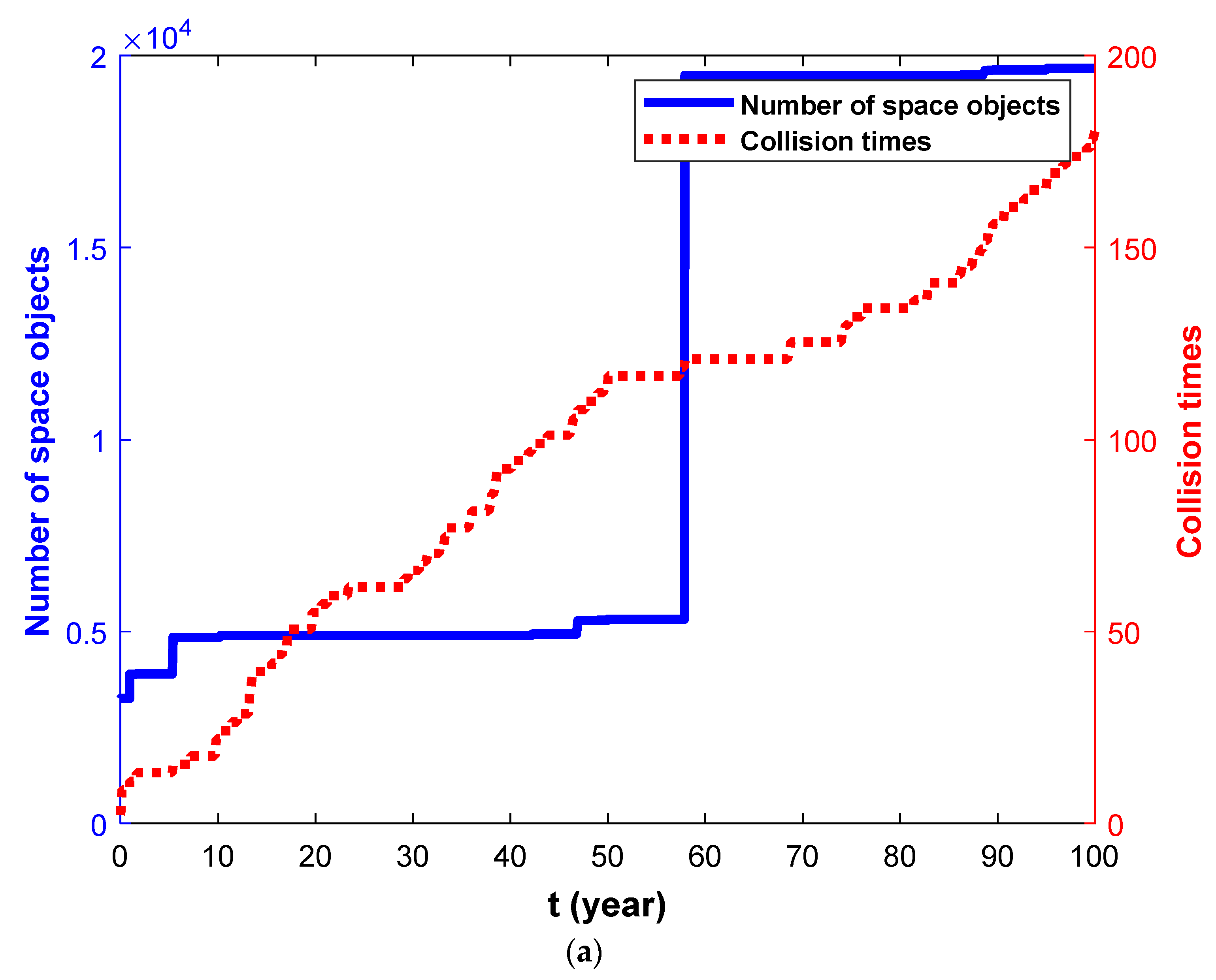
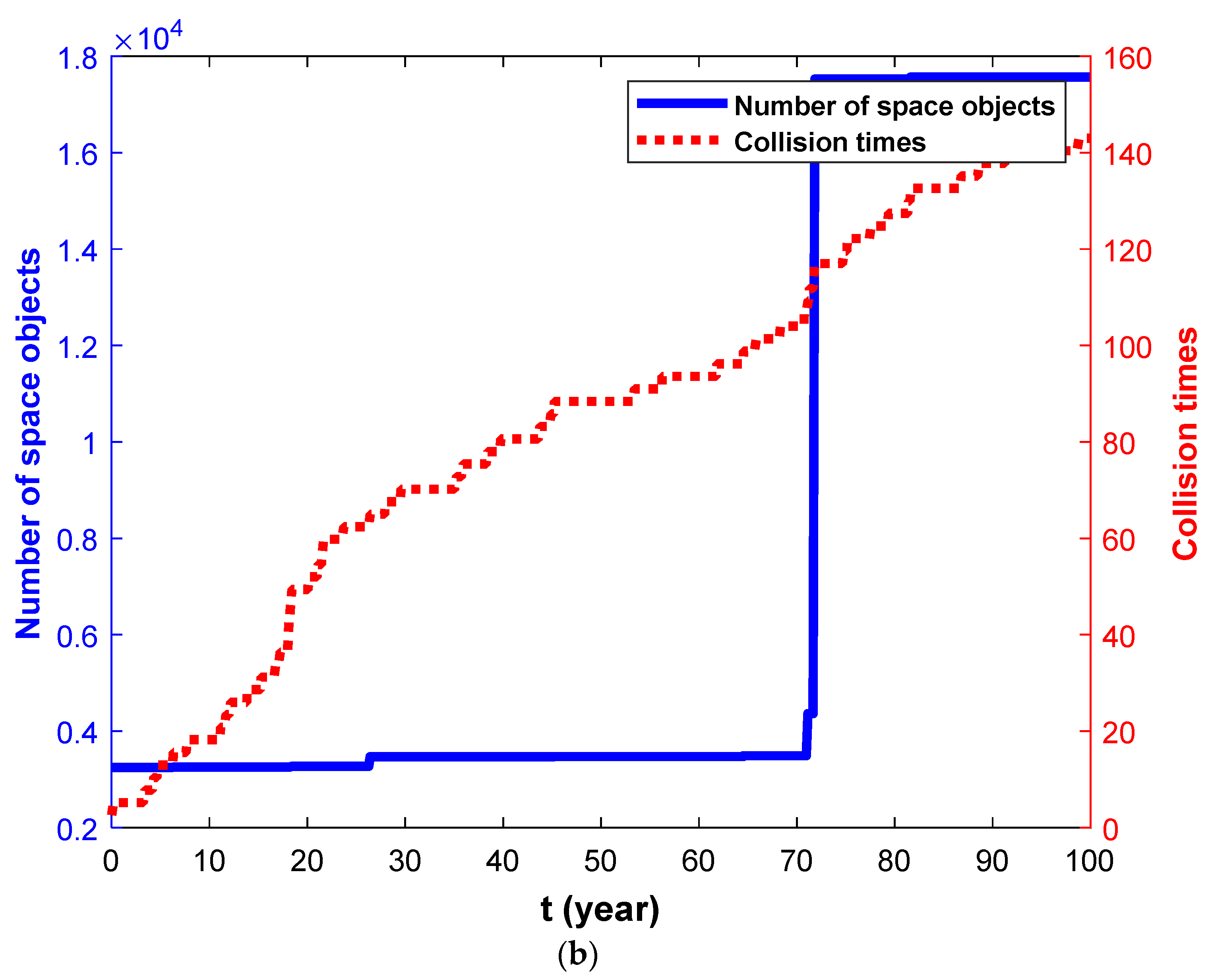
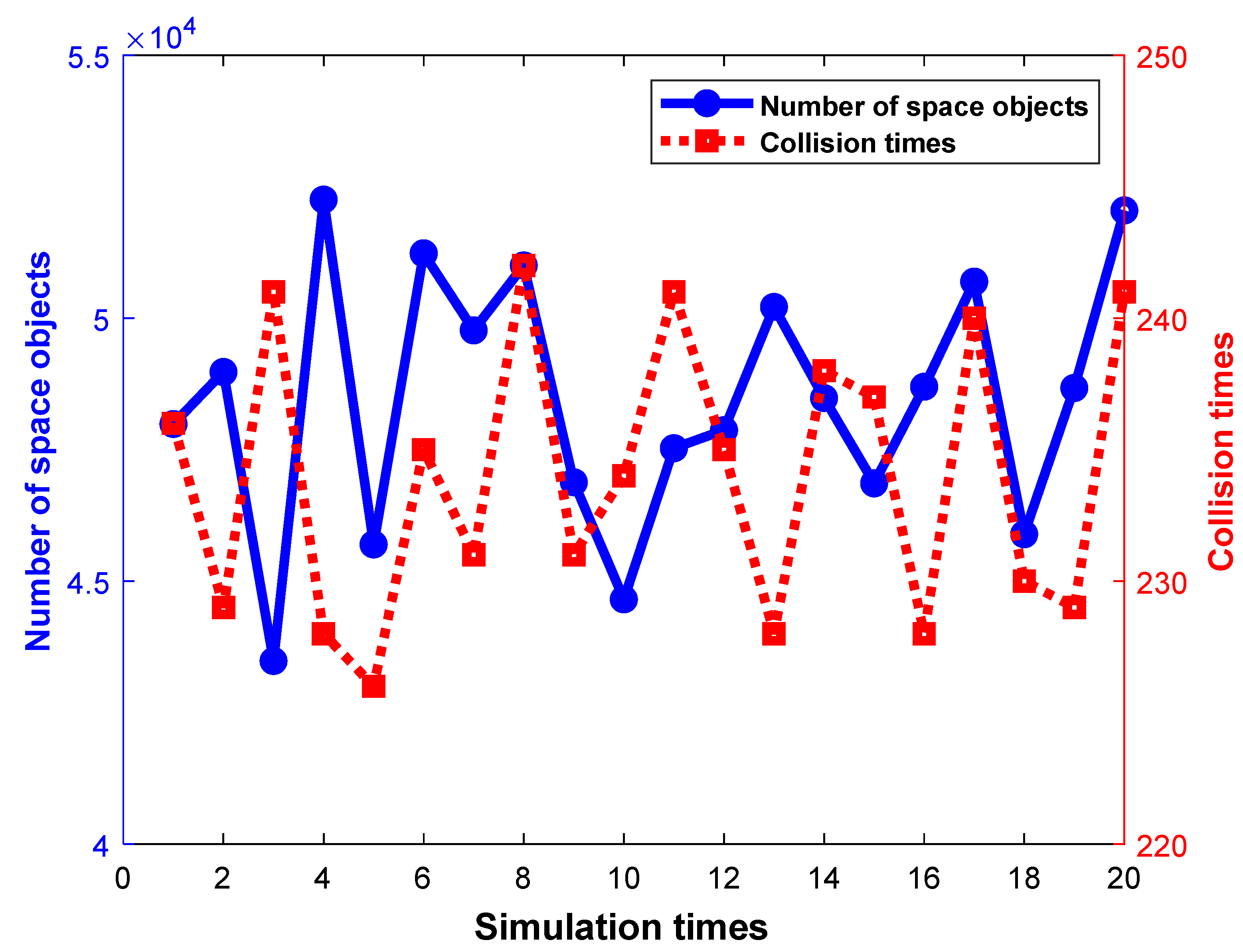


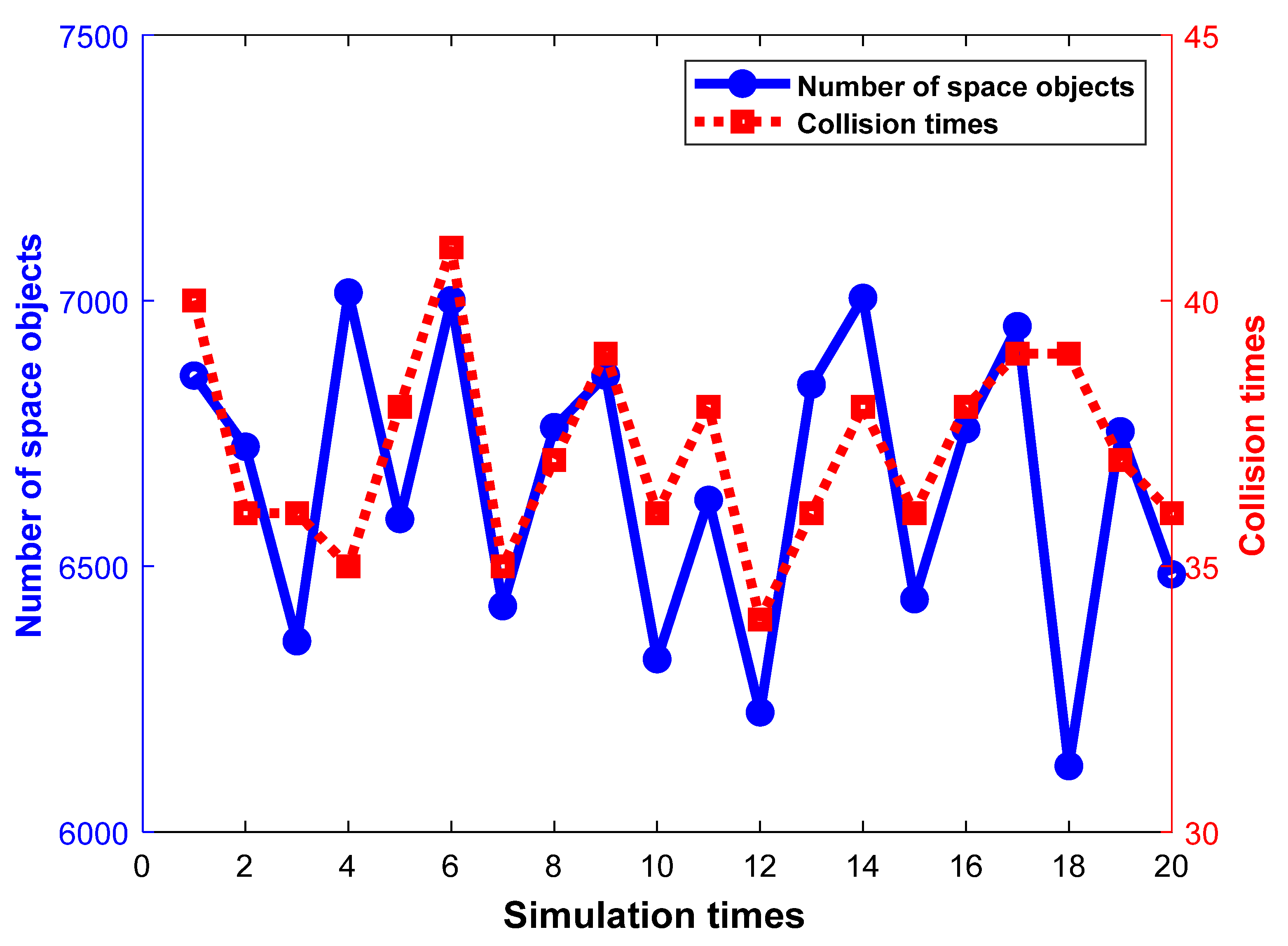
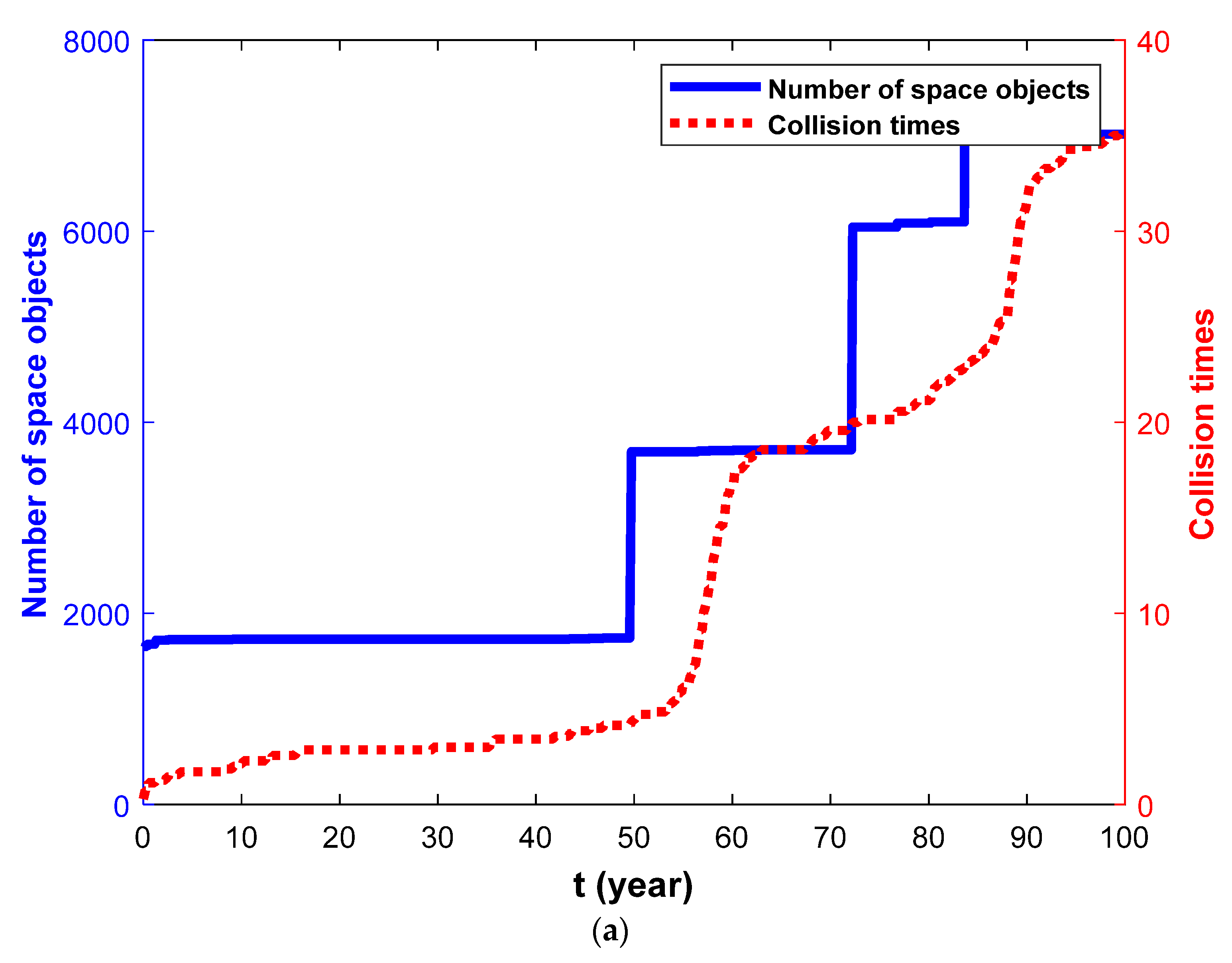


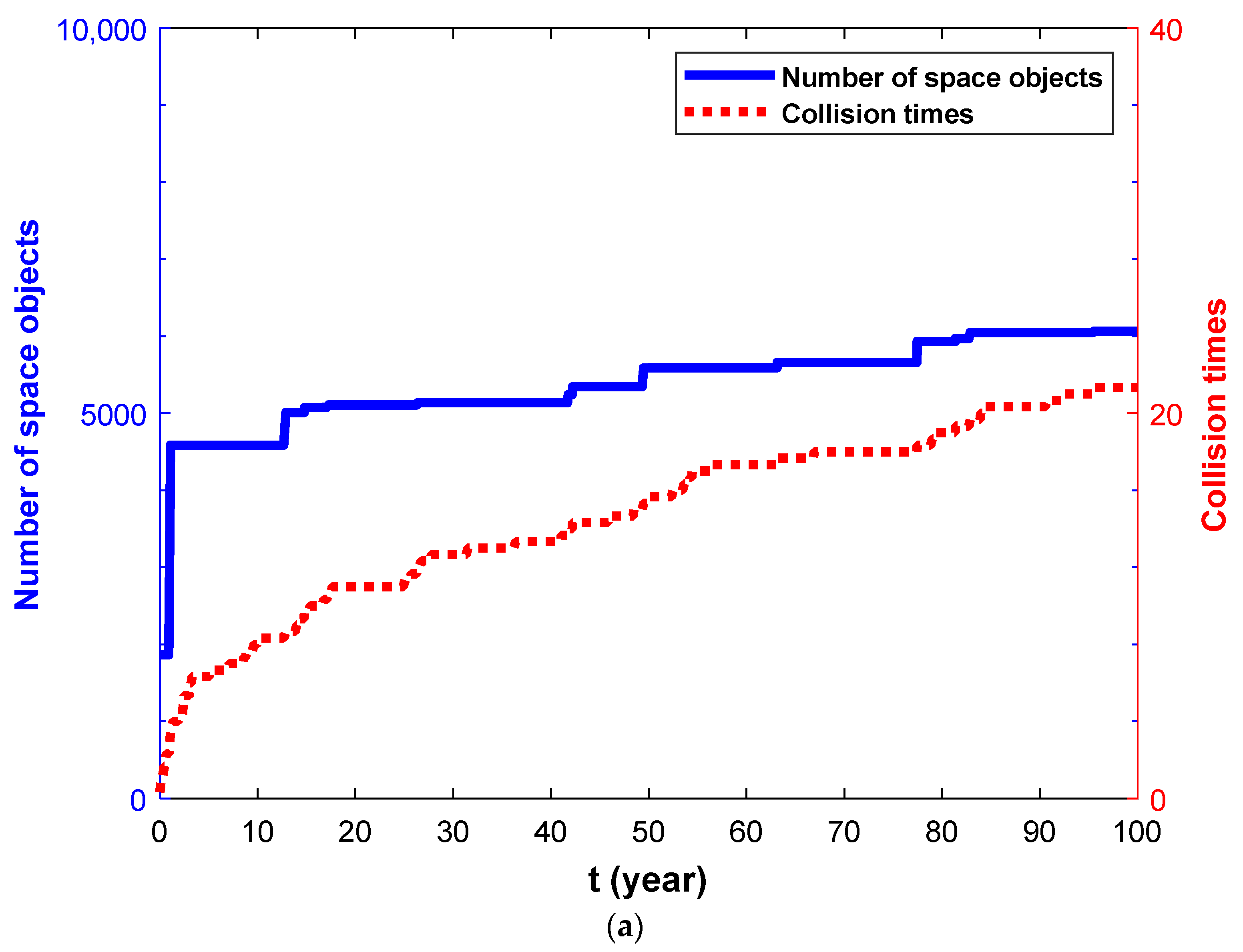
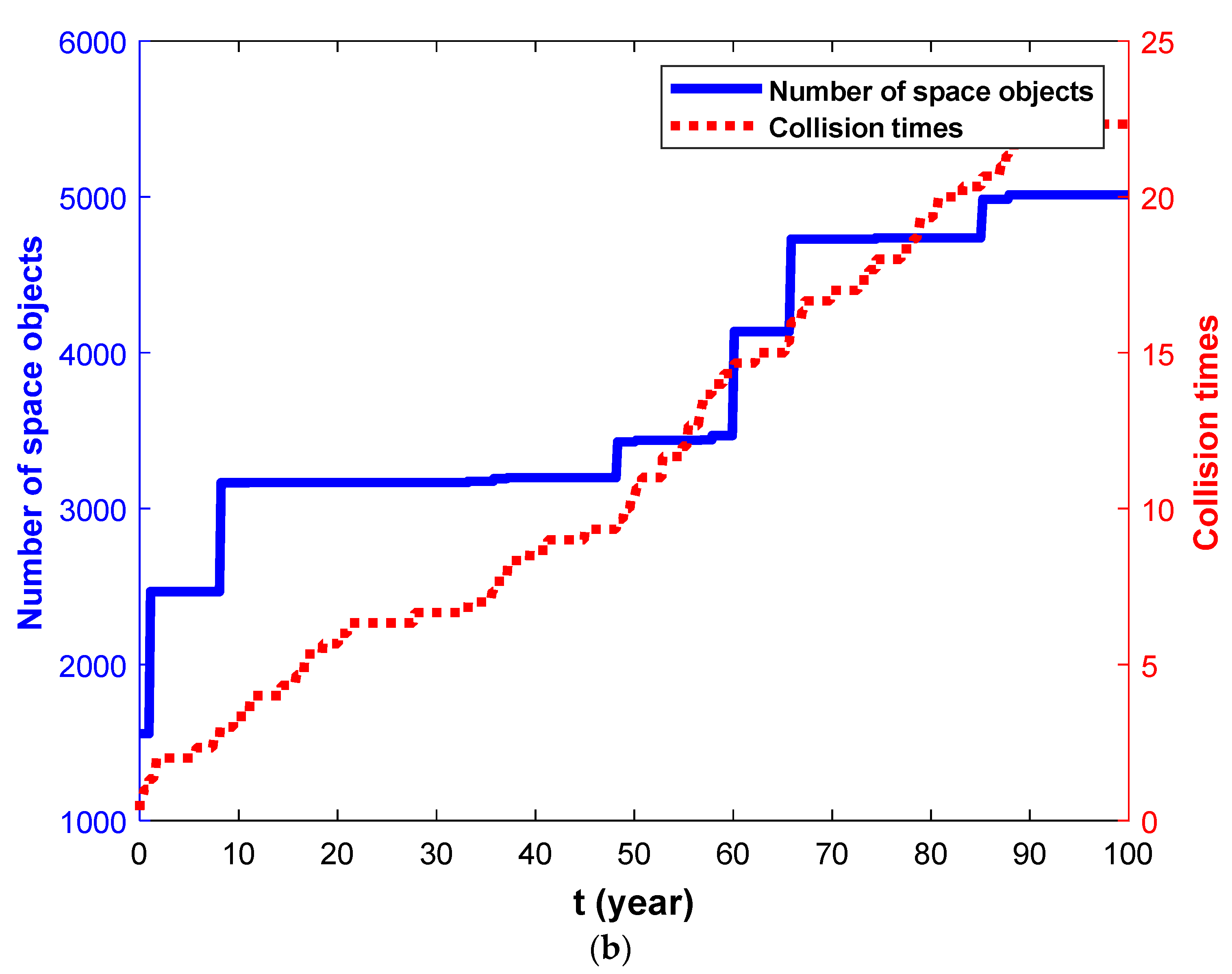
| Type | Debris Source | Mass | Collision Velocity | Disintegration |
|---|---|---|---|---|
| 1 | Molniya orbit | 25 | 2980.6 m/s | completely |
| 2 | GEO band | 330 | 802.6 m/s | completely |
| 3 | Molniya orbit | 8 | 2980.6 m/s | incompletely |
| 4 | GEO and | 8 | 802.6 m/s | incompletely |
| Element | Data | Element | Data |
|---|---|---|---|
| a/m | 26,556,000 | Ω/° | 156.639 |
| e | 0.7456 | ω/° | 345.037 |
| i/° | 63.40 | m/° | 244.247 |
| Element | Data | Element | Data |
|---|---|---|---|
| a/m | 26,556,000 | Ω/° | 336.639 |
| e | 0.6778 | ω/° | 0 |
| i/° | 63.40 | m/° | 0 |
Publisher’s Note: MDPI stays neutral with regard to jurisdictional claims in published maps and institutional affiliations. |
© 2022 by the authors. Licensee MDPI, Basel, Switzerland. This article is an open access article distributed under the terms and conditions of the Creative Commons Attribution (CC BY) license (https://creativecommons.org/licenses/by/4.0/).
Share and Cite
Zhang, H.; Li, Z.; Wang, W.; Zhang, Y.; Wang, H. Geostationary Orbital Debris Collision Hazard after a Collision. Aerospace 2022, 9, 258. https://doi.org/10.3390/aerospace9050258
Zhang H, Li Z, Wang W, Zhang Y, Wang H. Geostationary Orbital Debris Collision Hazard after a Collision. Aerospace. 2022; 9(5):258. https://doi.org/10.3390/aerospace9050258
Chicago/Turabian StyleZhang, Haitao, Zhi Li, Weilin Wang, Yasheng Zhang, and Hao Wang. 2022. "Geostationary Orbital Debris Collision Hazard after a Collision" Aerospace 9, no. 5: 258. https://doi.org/10.3390/aerospace9050258
APA StyleZhang, H., Li, Z., Wang, W., Zhang, Y., & Wang, H. (2022). Geostationary Orbital Debris Collision Hazard after a Collision. Aerospace, 9(5), 258. https://doi.org/10.3390/aerospace9050258






